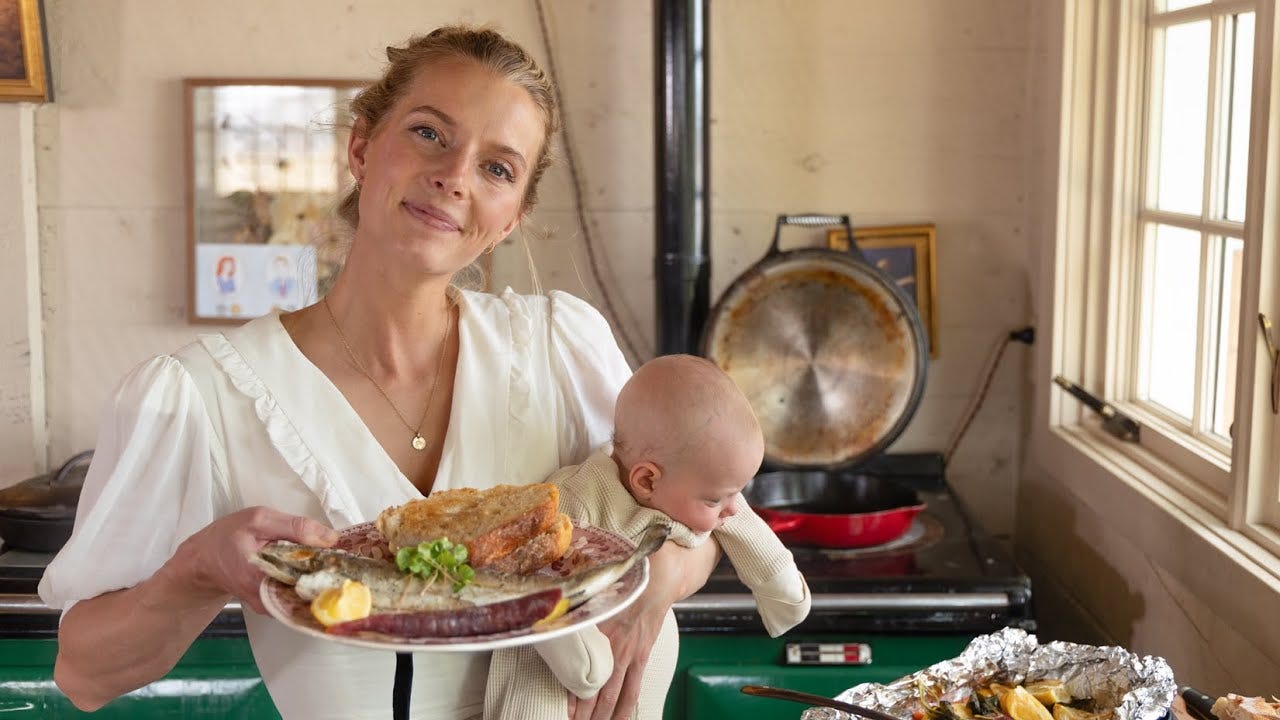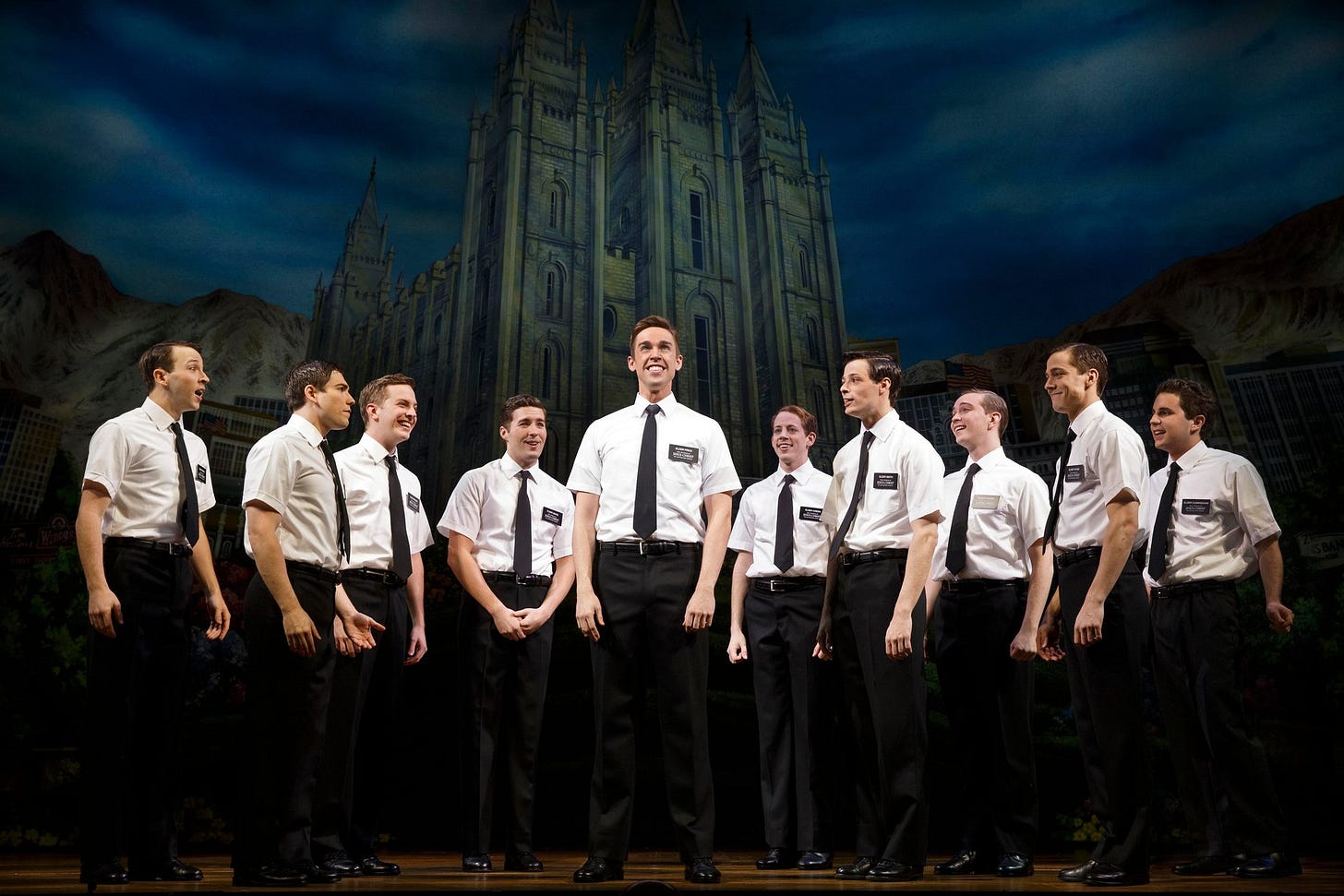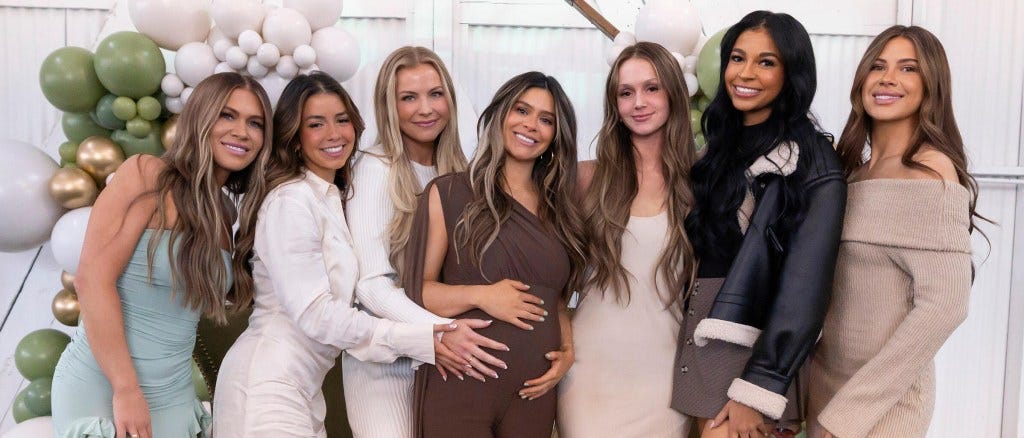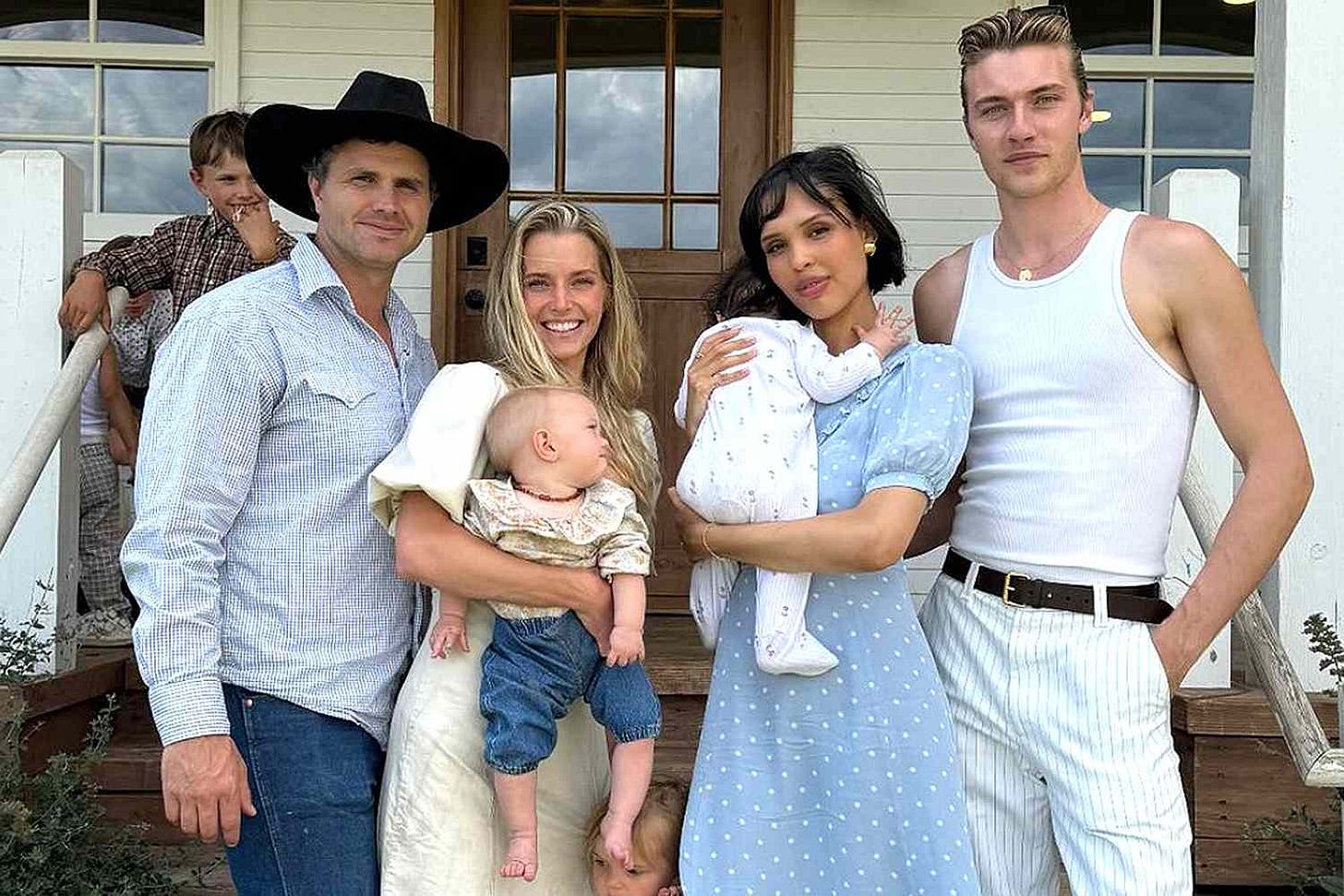Passive Proselytizing
Why All Your Favorite Influencers Are Mormons
The only social media app I have on my phone right now is Instagram, which at its best is a cross between Facebook and a mall. Fortunately for my attention span, the Instagram user interface is quite boring and easy to click away from, as are the people I follow: mostly former classmates, magazines, and celebrities who use the feed for earned media placements. Scrolling through Instagram is like looking through a yearbook, a Sears catalog, and an airplane safety pamphlet all in one.
It takes a quite compelling character to get me stuck on the Instagram app for more than fifteen minutes at a time. But there are several, and they’re characters you’re likely familiar with: Nara Smith and Hannah Neelman (or @ballerinafarm) - two women with many common denominators and just a few subtle differences. They are both known for posting elaborate cooking videos, making meals from scratch for their husbands and children. They’re both beautiful. They’ve both had many children at relatively young ages. They both live in relatively remote locations in the United States. The differences, however, lay in how they’re attempting to be perceived.
Smith’s content leans more comical (which I think is more intentional than most realize). She and her husband - 23 and 26, respectively - are professional models and look otherworldly, like citizens of the Capitol from The Hunger Games - high cheekbones, tight bob, often wearing well-tailored, elaborately sequined, and feathered outfits. The two just relocated from Texas to northern Connecticut, along with their three children. Smith will begin each video in a monotonous, sleepy tone, telling viewers that her husband had a midnight craving for a pot roast or something along those lines. After which, she’ll make the pot roast in full hair, makeup, and a designer gown, slicing the carrots and stirring the gravy dexterously, so as not to drag her elegant sleeve through it. The whole thing reads like a kind of charade.
Neelman on the other hand is much more earnest - more “salt of the earth.” She is thirty-four years old and a mother of eight. She and her husband, Daniel, live on a farm in Kamas, Utah, where they tend to livestock, milk cows, and feed their sourdough starter - the outputs of which can all be purchased on their website. The farm is named “Ballerina Farm,” inspired by Neelman’s past career as a professional ballerina.
Smith and Neelman have been subjects of online controversy, with many alleging that they’re promoting a “tradwife” lifestyle through their social media presence. A combination of “traditional” and “wife,” the term “tradwife” refers to a woman who subscribes to traditional gender roles in a heterosexual marriage, in which women bear the burden of homemaking and childrearing.
There have been countless think pieces on the rise and fall of trad-wifery over the past couple of years, particularly in light of Smith and Neelman gaining popularity alongside Trumpism in America. Many have claimed that the tradwife movement is a response to “girl boss” feminism which gained traction during Hilary Clinton’s 2016 presidential campaign, encouraging women to trade in their mom title for an executive title, grinding to outpace men on their way up the corporate ladder. While these connections are poignant, they’re often dancing around a key, dirty word - a concept that helps provide a more complete picture of American trad wife-dom, in my eyes: Mormonism.
Growing up out West, Mormonism was a common fixture of my upbringing - many of the blonde, blue-eyed kids I grew up with were raised in the faith. They were in my classrooms and ballet classes - at the grocery stores and pumpkin patches, shuffling their numerous younger siblings around. On the way to high school every day, I’d pass a giant Mormon temple that could be seen from miles away on the 405. A shiny gold angel sat atop it, blowing a horn.
Living in the greater Seattle area, most of the Mormon kids I befriended were more lax about their faith - like any teenager, they snuck out to party on the weekends and drank coffee when their parents weren’t around. Following high school, however, their spiritual tenets appeared to sharpen - they got married fairly quickly, often while still finishing college, and children will presumably be on the way.
It would be the understatement of the century to say that Mormonism has a bad rap in the United States. The Book of Mormon, a Broadway musical parodying the religion written by South Park alums Trey Parker and Matt Stone, won nine Tony Awards in 2011 and still runs on Broadway today. Mormons are the butt of jokes across sitcoms, dinner tables, and BYU campus street interviews. In 1982, historian Sydney E. Ahlstrom wrote that, depending on the context, “Mormonism” could refer to “a sect, a mystery cult, a new religion, a church, a people, a nation, or an American subculture; indeed, at different times and places it is all of these things.”
One of the main reasons why the Church of Jesus Christ of Latter-day Saints (otherwise known as LDS, otherwise known as Mormonism) has been made into a Western laugh-stocking is because of its lack of footing anywhere “ancient.” The religion was founded in Western New York by Joseph Smith - an American - who translated the Book of Mormon into English from writings he found on golden plates in a reformed Egyptian language. Smith said an angel showed him the location of these plates in 1823, buried in a nearby hill - they chronicle early Israelites leaving the Near East to travel to America, at the urging of God.
While Mormons make great efforts to recruit members worldwide, nearly nine out of ten Mormons are white. There’s long been controversy surrounding “plural marriages,” or polygamy in the Mormon church, which early Mormons in the mid-1800s were “commanded by God” to do to “raise up seed onto [Him]" (today, the Church prohibits polygamy).
However, undoubtedly, the most-discussed controversy surrounding Mormonism certainly relates to its treatment of women. Similar to many other religions, in the Mormon faith, women are not ordained to be priests but are encouraged to be dutiful homemakers and childrearers. In his 1987 talk “To the Mothers in Zion,” Ezra Taft Benson, president of the LDS Church, speaks to the “divine role to bear and rear children and bring them back to Him.” “No career approaches in importance that of wife, homemaker, mother – cooking meals, washing dishes, making beds for one's precious husband and children,” Taft remarks.
As such, the stereotypical Mormon woman has many kids and reliably performs unpaid labor inside the home. Like the gleaming image of a 1950s housewife, her role exists inside her and her husband’s house, emerging in the public only to do the grocery shopping and attend church service.
But today, Mormon women are quite visible to the public eye - often on their own accord. If you were to analyze a Venn diagram of popular parent influencers/vloggers and Mormon women, a single circle would be rendered. Hannah Neelman, Nara Smith, Amber Fillerup Clark, Brooklyn & Bailey, “Shaytards,” The Bucket List Family, the TikTok famous cast of The Secret Lives of Mormon Wives - all prominent family-oriented internet personalities. All with ties to Mormonism.
Social media has allowed what’s long been private to become public - permitting housewives who would historically be out of sight and out of mind to now be at the forefront of people’s entertainment feeds. Writer Fortesa Latifi, who’s writing a book about child influencers, interviewed several Mormon family vloggers on why Mormons, in particular, are rather predisposed to become influencers. For one, Mormons are encouraged to keep journals and scrapbooks of their family’s lives, particularly as children, which makes them primed for documenting their lives via social media. Rolling Stone writer Ej Dickson also shares that Mormon women tend to be conventionally attractive - blonde hair, blue eyes, and deterred from doing anything to de-beautify themselves, including smoking and drinking - making them physically fit to go viral.
For Allure, Professor Megan Sanborn Jones shared that Mormon women who want to work often engage in jobs that allow them to stay at home; mainly multilevel marketing operations like selling essential oils, nail polishes, skincare, and self-tanners out of their living rooms. Influencing isn’t so dissimilar - a means of selling products from home that allows for ample flexibility with childcare responsibilities. And with a much more handsome paycheck.
One former vlogger told Latifi that “there is a tremendous push from the church itself and from its general authority leadership to be public with your faith and your lifestyle and share it with the world.” In her recent memoir, The House of My Mother, Shari Franke - daughter of the infamous “8 Passengers” Mormon vlogger Ruby Franke - refers to vlogging as a form of “passive proselytizing” - a less direct means of missionary work. Influencing might be a modern means of sharing your faith with the world - in any capacity.
It becomes harder to tell where certain personalities fall on the influencer-entertainer continuum - as more internet-famous people cross over to “mainstream famous.” “Influence” is, of course, in an influencer’s title, but you have to wonder how much of their gig is about persuading people, so much as it is about entertaining. You have to think that Nara Smith and Hannah Neelman know how other women look at them - with envy, with contempt, with wonder - and consider that their tableaus are composed for every type of viewer. An influencer must sell products to make money but must get the public’s attention first. Which can be done efficiently by leaning into caricatures.
Everyone active online posts with the intention to be viewed in some kind of way. We are all passively proselytizing, as it were - not necessarily trying to convince people to convert to a particular religion, but certainly trying to convince them that we are a certain way. Artistic, alternative, intellectual, uninterested in vanity. A sharp-tongued culture critic, a devout Mormon wife. Proselytizing about our toxin-free, God-honoring life and then proselytizing about an all-cotton T-shirt company or an essential oil brand. Or about the goods grown on your farm and your slow parenting lifestyle, showcasing your children’s faces as a means to gain funds to pay for food to feed said children. Propping up the camera and pressing “record” before milking the cow or kneading the dough. Painting the picture that will best sell the T-shirt, the sourdough starter, or the idea. Perhaps influencer isn’t as good of a title as “impressionist” is.








A very interesting piece for sure! I study religion, and as such my Instagram is FILLED with religious “influencers” from everything from Mormonism to Orthodox Judaism to greek orthodoxy to deconstructing evangelicals to the rather bizarre “nation of Islam.” I’m constantly interested with and engaging with people who are showing their religious lifestyle online, and I have thought lots about how interesting it is that these Mormon influencer women are often less blatant or upfront about it— seemingly trying to portray their lives as simple, beautiful, traditional homemakers, with only a slight caption reference to Jesus or one video every so often of “grwm for church”. Other religious women influencers have content like Miriam Ezagui (who I LOVE) who starts every video with an audience-asked or common question/misconception and then says “hi, I’m Miriam, and I’m an orthodox Jewish woman sharing my daily life” and then proceeds to answer the question. Her religion and many others’ is quite upfront rather than more hidden as a backbone of her aesthetic, like it is in ballerinafarm (which I have also followed for several years).
Interestingly, just yesterday I met with 2 LDS missionaries. I have a project of trying to visit new types of churches each week to learn more (yeah, I’m a nerd, I’m obsessed with religion), and when I asked in an online form for my local LDS church what I could expect from a service, they reached out to meet up. I had a really good time talking to these two “elders” (a 22 year old boy and an 18 year old boy) and I didn’t pull any punches— asking hard questions about gender and women’s role in the church, the problem of evil, ethics of missionary work especially when it aids in erasure of indigenous or local religion and goes hand in hand with colonialism, and lots of other things. I was upfront that I didn’t think I would ever convert but liked learning, and they appreciated my attentiveness, note taking, curiosity about their lives, and my hard questions which one said “he’d never thought about before.” They generally answered the questions well and though I disagreed with a lot I also learned a lot.
Anyway, I thought your piece was very interesting, as the trend of these homemaker women influencers being Mormon is something I’ve noticed and thought about for a long time. I also follow several Messianic Jew women homemaker influencers, and it’s quite interesting to see them interacting online with some Mormon or evangelical women influencers. These women follow each other, comment on each others posts, or even meetup. They’re all particular (somewhat extreme or abnormal to me) strains of Christianity, with particularly enforced ideas of womanhood that have influenced how all of them show their own womanhood and which relate them together in their homemaker-for-Christ roles.
I'm an exmormon and this is such an interesting piece! There's something to be said about the fact that there's a lot of performance in Mormon culture. People notice if you miss church and visit you, you're taught to be a good example to others so they become curious about the church, you're taught to "avoid the appearance of evil" by not publicly consuming anything that looks remotely like alcohol or coffee, etc. I also think it's interesting that while these influencers you've mentioned have ties to Mormonism, within Mormon culture they're pretty much "disowned" and not considered faithful Mormons because many of them clearly do not wear the Mormon garment/underwear which is another metric by which Mormons are judged if they are faithful/worthy. Just a quick note too: the former president to the church you mentioned is Ezra Taft Benson, not Ezra Taft.